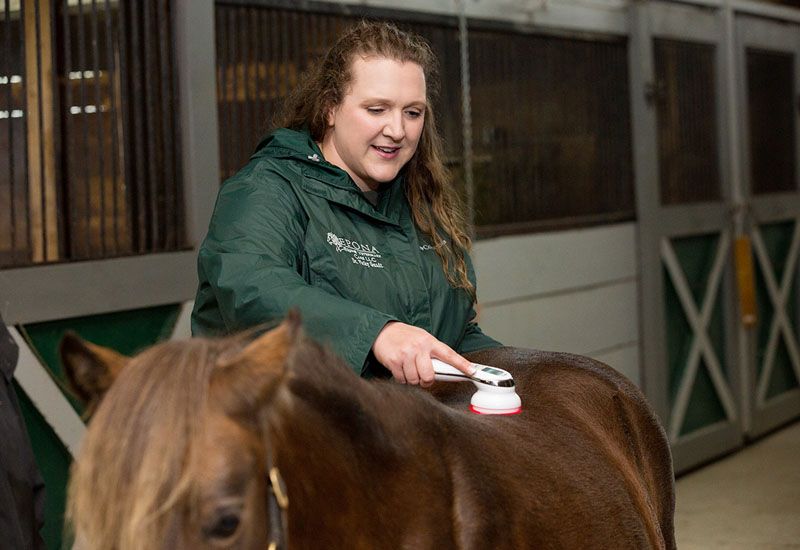How Laser Therapy in Horse Treatment Is Transforming Veterinary Treatment for Horses
Laser treatment has actually emerged as a transformative technique in equine veterinary treatment, giving a non-invasive remedy that quickens healing and enhances overall health. Leveraging specific light wavelengths, this cutting-edge treatment boosts cellular regrowth, reduces inflammation, and alleviates discomfort. Its efficiency expands from musculoskeletal injuries to chronic ailments like osteo arthritis, significantly enhancing flexibility and life top quality for equines. The transportability and adaptability of laser therapy tools better highlight their expanding indispensability among veterinarians. As we explore the elaborate mechanics and real-world successes, the profound influence on equine medical practices comes to be significantly obvious.
Recognizing Laser Treatment

The innovation behind laser therapy is grounded in the principle of photochemistry, where photons are taken in by chromophores within cells, causing increased ATP manufacturing and inflection of responsive oxygen types (Equine Therapy). This, in turn, promotes mobile proliferation, lowers swelling, and increases healing. Veterinary practitioners make use of various sorts of lasers, including low-level lasers (LLLT) and high-power Class IV lasers, depending upon the specific restorative purposes and the nature of the equine condition being dealt with
Different laser wavelengths and power setups are meticulously selected to target numerous tissue depths and accomplish wanted medical end results. Safety procedures are critical, as inappropriate use can lead to thermal damage or suboptimal restorative results. Therefore, a detailed understanding of laser therapy's devices and applications is vital for its effective application in equine vet technique.
Benefits for Horse Wellness
The myriad benefits of laser treatment for equine wellness encompass boosted recovery, pain decrease, and boosted movement. This sophisticated treatment method leverages particular wavelengths of light to penetrate tissues, promoting mobile function and promoting fast tissue repair work. The non-invasive nature of laser treatment makes certain marginal stress and anxiety and pain for the steed, helping with a smoother recuperation procedure.
Boosted recovery is one of the leading advantages, as laser therapy speeds up mobile regrowth and collagen synthesis. This brings about faster healing times from injuries and procedures. Discomfort reduction is achieved via the anti-inflammatory impacts of laser treatment, which decreases swelling and decreases the production of pain-inducing chemicals. As an outcome, steeds experience substantial relief from chronic and severe discomfort problems.
By reducing inflammation and pain, and improving tissue repair work, laser treatment helps in restoring joint function and muscle versatility. Hence, laser treatment stands as a transformative tool in modern-day horse veterinary treatment.
Common Conditions Treated
Laser therapy has arised as a functional therapy alternative for a range of typical equine problems. Furthermore, laser treatment is reliable for problems like osteoarthritis, where it aids minimize joint inflammation and advertise cells repair.
Wound administration is an additional area where laser treatment has actually shown substantial guarantee. Chronic wounds or slow-healing ulcers can be specifically challenging in equines, but laser therapy enhances mobile regrowth and enhances blood circulation, therefore speeding up the healing process. Moreover, laser treatments have been effectively employed in taking webpage care of unguis problems such as laminitis and abscesses, relieving pain and promoting quicker recovery.

Technology Behind Laser Treatment
Beyond the myriad problems treatable with laser treatment, the technology itself advantages better exam. At the heart of laser therapy is making use of certain wavelengths of light to pass through tissues and generate organic actions. These wavelengths, typically varying from 600 to 1000 nanometers, are uniquely absorbed by chromophores in the skin, muscular tissue, and various other cells, initiating a waterfall of cellular events.
Laser gadgets utilized in veterinary medication commonly use low-level laser therapy (LLLT) or cool laser treatment. Unlike high-powered surgical lasers, these devices run at reduced energy degrees, optimizing restorative benefits while reducing thermal damage. The power from the laser light promotes adenosine triphosphate (ATP) manufacturing, enhances mobile metabolism, and increases tissue repair service procedures.

Success Stories and Study

Showcasing the substantial benefits of laser therapy, countless success tales and instance research studies illuminate its transformative effect on equine health and wellness. One such situation includes a pure-blooded racehorse struggling with persistent tendonitis. Traditional therapies produced minimal enhancement, but after incorporating laser treatment into the routine, the equine showed substantial decreases in inflammation and pain within website here weeks, ultimately returning to affordable racing.
Another engaging example includes a dressage horse diagnosed with serious neck and back pain, restricting its efficiency. A vet group used low-level laser treatment (LLLT) to target the irritated locations, causing significant renovation in adaptability and a significant decrease in discomfort. Over a number of sessions, the equine reclaimed its peak kind, showcasing the efficiency of laser treatment in addressing musculoskeletal issues.
Additionally, a research study carried out at a leading equine clinic checked out 50 equines with various soft cells injuries treated with laser therapy. The outcomes were striking: 85% of the equines demonstrated increased recovery times and enhanced flexibility. These situations emphasize the versatility and efficiency of laser therapy in equine medication, providing a non-invasive, scientifically-backed strategy to boosting recuperation and performance in steeds.
Conclusion
Laser therapy is changing equine vet investigate this site care by providing a non-invasive therapy that increases recovery, decreases inflammation, and eases pain. With its performance in treating an array of conditions, from musculoskeletal injuries to persistent disorders like osteo arthritis, this technology dramatically improves equine health and flexibility. The transportability and flexibility of laser therapy even more highlight its transformative effect on vet methods, strengthening its function as a necessary device in modern equine healthcare.